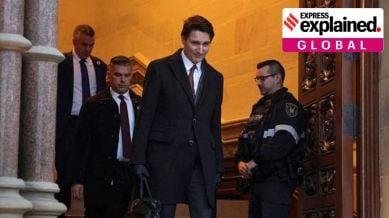Trudeau’s ally to move no-confidence motion against him: What’s behind the ongoing political crisis in Canada
The no-confidence vote is expected to be moved in late January next year after the winter break of the House of Commons

Canadian Prime Minister Justin Trudeau’s days at the helm may well be numbered as his key ally, New Democratic Party (NDP) leader Jagmeet Singh, on Friday (December 20) said he would introduce a no-confidence vote against the prime minister. The no-confidence vote is expected to be moved in late January next year after the winter break of the House of Commons.
What triggered the current crisis?
The first stone was cast in late November when US President-elect Donald Trump threatened 25-per cent tariffs on Canada and Mexico, over their alleged failures to control the flow of illegal drugs like fentanyl, and illegal immigrants. This prompted widespread questioning about Trudeau’s ability to handle the fallout, and he rushed to meet with Trump, assuring him of stricter border controls.
monthly limit of free stories.
with an Express account.
Tensions came to a head last Monday (December 16) when Deputy Prime Minister and Finance Minister, Chrystia Freeland, announced her resignation. This shocking announcement came hours before her scheduled fall economic update to the parliament.
According to a Reuters report, the budget document indicated a C$ 61.9 billion (nearly $43 billion) budget deficit for 2023-24, drastically exceeding projections.
In her resignation letter, Freeland said the PM “no longer wanted” her to serve as the finance minister and had offered her a different cabinet post. She also cautioned against the possibility of a costly trade war with the US as it pursues a “policy of aggressive economic nationalism” and the need to counter it by “keeping our fiscal powder dry today”.
Over the last week, MPs from the Liberal Party, to which Trudeau belongs, have demanded that he resign.
Signs of a larger problem?
Freeland’s resignation marks the latest in a massive exodus in the current cabinet, which has seen eight ministers exit in recent months.
The Liberal Party has presided over rising political divisiveness and inflationary pressures. A key point of contention has been the soaring housing crisis, characterised by spiralling house prices and increasing homelessness.
In October, nearly two dozen MPs signed a letter calling for Trudeau’s resignation. The party witnessed historically low approval ratings, with an Ipsos survey in October rating its approval rating at 33% behind its rival the Conservative Party (45%). Trudeau’s own approval rating had fallen to 26%.
The Liberals, which last won the election in 2021, lost the support of the left-wing New Democratic Party in September. With NDP leader Jagmeet Singh saying that he would introduce a no-confidence vote against the party, an early election seems imminent.
The party’s chances of winning are at an all-time low for the first time in a decade. The Conservatives, led by Pierre Poilievre, a right-wing populist leader, are currently projected to win.
What next for Trudeau?
So far, the Canadian Prime Minister has shown no indication of quitting, at least not before Christmas, according to a report in The Globe and Mail. The report also said that Freeland was being propped up for leadership by members of the Liberal Party.
Should Trudeau resign, an interim leader will be elected to serve the remainder of the term until the party elects a new leader.
If the no-confidence vote does proceed in January, the Liberal Party is expected to lose.The government would need the support of a majority of the 338 members in the House of Commons to survive a confidence vote, which the party is currently short of. While past attempts by the Conservatives to trigger a confidence vote have failed, the NDP’s withdrawal of support makes elections imminent.
A third option would be to ‘prorogue’ the parliament, effectively a suspension of parliament without its dissolution. Trudeau may choose to exercise this option in the interest of continuing a current government policy, and bypass the no-confidence vote. This option was exercised in August 2020 following a charity scandal, and in 2008 by former PM Stephen Harper to save his government from being toppled by a coalition of opposition parties. However, Trudeau risks alienating support within his party in the process.